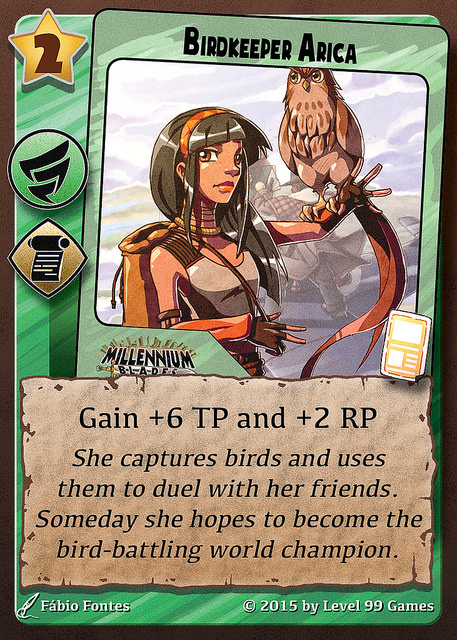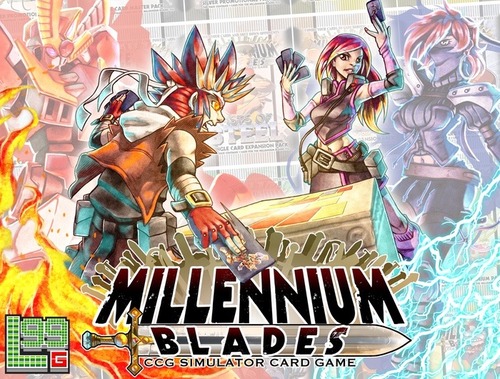As part of our June Spotlight on Millennium Blades, we strive to inform the readers of little extra tidbits surrounding the game. Games are made by people, and one of those tidbits we enjoy is learning a little bit more about the people behind them. Some designers shy away from the public stage, while others enjoy being front and center. In the case of Millennium Blades designer D. Brad Talton, the best place to find him is usually at a table waiting to show off his latest creation. As the head of Level 99 Games, Brad has been designing, publishing, and showcasing his games for years, and yet for all of his brand’s growth, one of the most rewarding things to him remains the sheer act of sharing what he’s created first-hand. Always the consummate designer, that one.
While not wholly encompassing of the entire Level 99 game line, the company does have a propensity for many classic game themes, from its 8-bit Pixel Tactics line to its highly successful BattleCon, an arcade-style fighting game. Millennium Blades is the latest in that tradition, though arguably unlike most games you’ve come across before. Mostly because, well, this is a game about a game. Or, rather, an entire game system. Millennium Blades is billed as a complete CCG simulator, celebrating all ups and downs that are well known within the collectible card game genre. This game allows you to dive into the robust card-slinging world made famous by titles like Pokemon, YuGiOh, and Magic: the Gathering without the long term investment. Feel the experience of cracking open packs, building decks, trading cards, and ultimately, trying to make it big in the tournament scene, all through the glory of the game’s CCG, known of course, as Millennium Blades.
It’s a little meta, but it works.
So how did this entire game come to be? We sat down at one of Brad’s gaming tables to find out. Enjoy!
Round One Questions
CR: What was your Gateway Game?
The first real hobby game I played was Pokemon TCG, but I didn’t really get into games until Magic and YuGiOh, which I played really heavily. I didn’t realize that boxed ‘designer games’ existed until college, when I got to play titles like Arkham Horror, Illuminati, and a bunch of the Cheapass [Games] titles. That was when I realized there was a board game hobby besides CCGs that I could potentially get involved in.
CR: What was the last game you really enjoyed playing (besides Millennium Blades)?
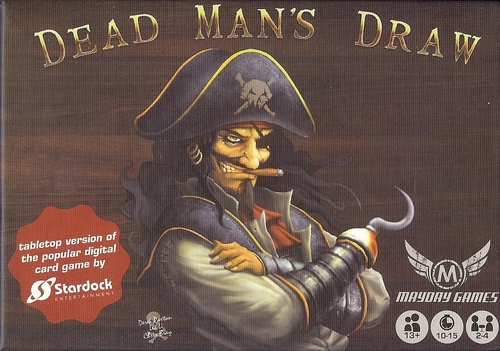 I had a lot of fun playing Dead Man’s Draw over my summer vacation. I’ve really enjoyed the simplicity and strategy present in those cards.
I had a lot of fun playing Dead Man’s Draw over my summer vacation. I’ve really enjoyed the simplicity and strategy present in those cards.
CR: How big is your game collection?
CR: What is your favorite type of game to play?
CR: How do you feel about Monopoly?
I think it’s an important cultural piece and will always have its place. However, I feel that Hasbro has done a better job of modernizing its other titles (Risk, Stratego, and the like). Monopoly remains strangely unimproved despite its many iterations.
On Millennium Blades
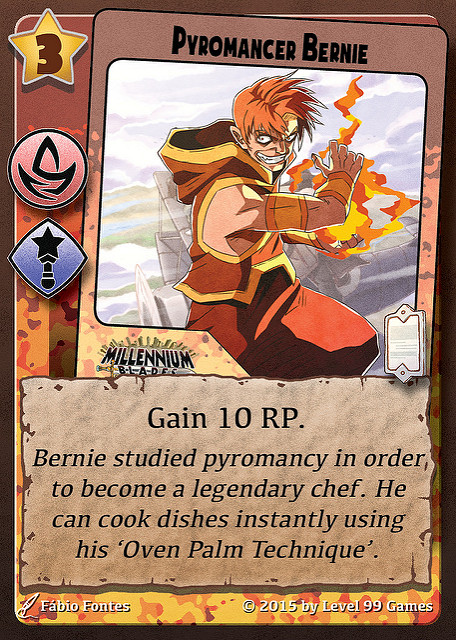 CR: First off, what prompted you to come up with the idea for a game simulating a CCG environment? We sense a story here…
CR: First off, what prompted you to come up with the idea for a game simulating a CCG environment? We sense a story here…
My friend got me playing an online trading card game – one of the really awful ones from Mobage where all you do is click the app every 5 minutes to unlock cards, and you can pay money to unlock them faster. I got to thinking ‘I know this game is absolutely awful, but why am I still compelled to click that button? Is there something inherently exciting about opening booster packs? Can I tap into this as the core concept of a game?’ From that, I starting thinking about designing a game that would let me open bunches of booster packs.
CR: You said you’ve played a number of CCGs. Which ones? And how did that factor into the game’s design?
Yes, a lot of them! Magic, YuGiOh, and Pokemon, of course. A few more obscure ones too. My favorites were the Fullmetal Alchemist Trading Card Game and Anachronism (the History Chanel Card Game). I don’t know if these factored in much, except in the sense of theming the different sets.
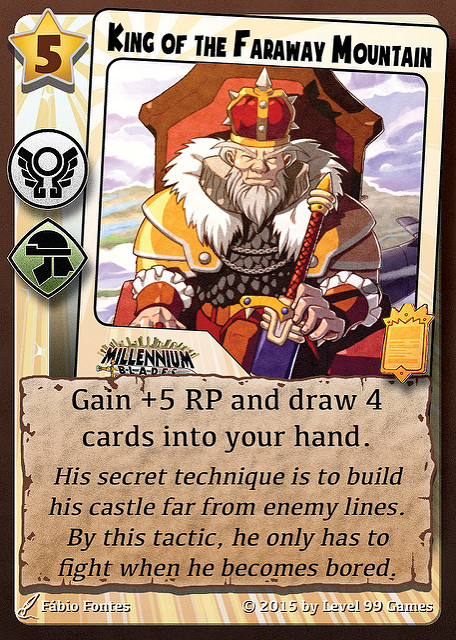 CR: Part of the game focuses on the entire collectible game meta itself, from trading cards to tournament play. Was your focus always on the entire CCG experience or just the card game itself?
CR: Part of the game focuses on the entire collectible game meta itself, from trading cards to tournament play. Was your focus always on the entire CCG experience or just the card game itself?
It was always about the whole experience. Since we began with ‘opening packs’, we knew that the player was going to be in the seat of a CCG player and that they would have experience outside tournaments. The tournament and the deckbuilding phases weren’t always separate, but even from the start there were different roads to victory and different things to do with your trading cards besides just play them.
CR: How did the name Millennium Blades for the game come about?
I wanted a name that would be equal parts exciting and hokey. “Millennium Blades” is a name that sounds really cool when you say it seriously, but if you actually analyze it, the meaning falls apart pretty quickly. There’s some story about one thousand mythical swords created a thousand years ago, but that never really makes it to the players…much like the typical CCG backstory!
CR: The game strives to provide the whole CCG experience in a box, even (or especially) for those who have never been part of that side of gaming. How much effort went into making the game accessible to those players?
I couldn’t tell you how many nights I laid awake and wondered if players were going to “get it”. We put a bunch of effort into making the game accessible, going as far as to include an entire extra game phase (the pre-release tournament) that functioned purely as a tutorial. I’m very pleased with how successfully the game has managed to teach itself to players.
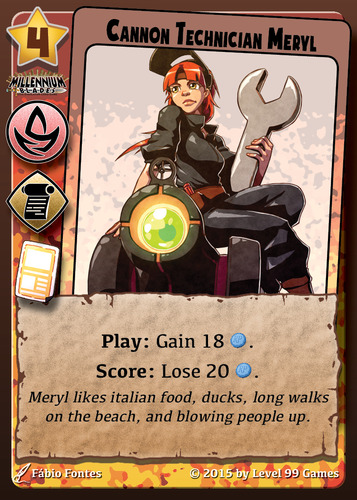 CR: Like many other titles in the Level 99 library, this one has a very anime-inspired art style. Was that deliberately chosen as part of the CCG aspect of Millennium Blades or some other reason?
CR: Like many other titles in the Level 99 library, this one has a very anime-inspired art style. Was that deliberately chosen as part of the CCG aspect of Millennium Blades or some other reason?
I chose the artist for the game, not the style. Fábio Fontes is an extremely capable and reliable artist. I knew without a doubt that he could produce the 300+ pieces of art the game required, and I let him decide how he wanted to execute on that. From the very first character drawn (Malcombe, from the Fire Starter deck), the project has been a partnership between the two of us, and I don’t think it would ever have happened without him.
He’ll be at Gen Con 2016 to sign copies of Millennium Blades or Pixel Tactics, by the way!
CR: One of the clever things about this game is that although primarily a deckbuilder with some economic aspects to it, you have ways of winning other than simply having a faster or better deck than your opponent. Was that a design choice from the start or did that evolve over time?
There were always different paths to victory, but originally those paths all filtered into the tournament victory. Over time, we evolved to make some effects grant victory points outside of tournaments, and it created an interesting balance when combined with the limited time phases of the deckbuilding step.
CR: Finally, we have to know: what’s your favorite deck archetype style? And what must we do to defeat it and claim ultimate victory?
Millennium Blades drops you right in the middle of the quest to become the best tournament player around. This CCG simulator in a box has the potential to take even the most basic card-flopping rookie and make them into a champion. It provides all of the materials you need to hone your skills and, if all goes well, will end with you taking on even the most tenacious opponents the game can muster. The only thing it’s missing is a montage.
Of course, this game will only be a test. To become a true Millennium Blades celebrity, you will have to rise in the ranks and take on the tournament scene yourself. Do well enough, though, and you’re looking at fame, some cash income, corporate sponsorships, and all the adoration from the fan base you could ask for.
We can’t help you win. But we can help you find out if you have what it takes to become a winner. Do you think you can make it big? There’s only one way to find out, and we’re giving away a chance for one of you to determine your future right…now.
Photo Credits: Millennium Blades cover and artwork by Level 99 Games.

